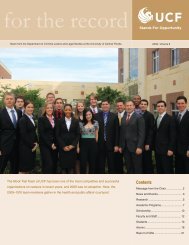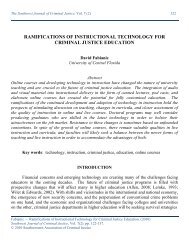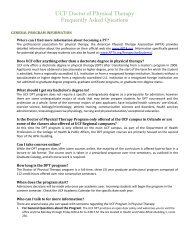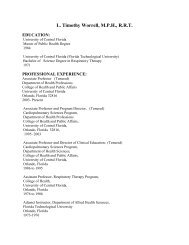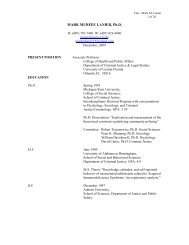Beyond Anomie: Alienation and Crime - University of Central Florida
Beyond Anomie: Alienation and Crime - University of Central Florida
Beyond Anomie: Alienation and Crime - University of Central Florida
You also want an ePaper? Increase the reach of your titles
YUMPU automatically turns print PDFs into web optimized ePapers that Google loves.
Crit Crim (2008) 16:1–15<br />
DOI 10.1007/s10612-007-9047-z<br />
<strong>Beyond</strong> <strong>Anomie</strong>: <strong>Alienation</strong> <strong>and</strong> <strong>Crime</strong><br />
Hayden P. Smith Æ Robert M. Bohm<br />
Published online: 6 December 2007<br />
Ó Springer Science+Business Media B.V. 2007<br />
Abstract This paper argues that anomie theories are aspects <strong>of</strong> the more comprehensive,<br />
but neglected theory <strong>of</strong> alienation. The dominant dimension <strong>of</strong> anomie theories (particularly<br />
Durkheim’s version) is normlessness, which is only one <strong>of</strong> five dimensions <strong>of</strong><br />
alienation theory. A practical implication <strong>of</strong> this insight is that anomie theory relies heavily<br />
on a Durkheimian focus on the role <strong>of</strong> normlessness in guiding criminal justice policy,<br />
while the other dimensions <strong>of</strong> alienation theory-powerlessness, meaninglessness, isolation<br />
<strong>and</strong> self-estrangement—have been deemphasized or ignored. By including all dimensions<br />
<strong>of</strong> the alienation concept, an integrated theory <strong>of</strong> crime <strong>and</strong> more effective crime control<br />
strategies can be formulated.<br />
Introduction<br />
Durkheim’s theory <strong>of</strong> anomie has displayed remarkable staying power for more than a<br />
century. The theory has been repeatedly revised <strong>and</strong> exp<strong>and</strong>ed. Ironically, none <strong>of</strong> the<br />
versions <strong>of</strong> anomie theory specifically addresses the linkages between anomie theory <strong>and</strong><br />
the more comprehensive, but neglected theory <strong>of</strong> alienation. We contend that the dominant<br />
theme <strong>of</strong> anomie theories (particularly Durkheim’s version) is normlessness, which represents<br />
only one <strong>of</strong> five components <strong>of</strong> a broader theory <strong>of</strong> alienation. This emphasis placed<br />
on ‘‘norms’’ by anomie theorists continues to support mainstream criminology policies that<br />
reinforce equilibrium, control <strong>and</strong> maintenance <strong>of</strong> the status quo.<br />
In response, we explicate the potential efficacy <strong>of</strong> the concept <strong>of</strong> alienation; specifically,<br />
this article examines the remaining alienation components <strong>of</strong> powerlessness, meaninglessness,<br />
isolation <strong>and</strong> self-estrangement. This endeavor includes an examination <strong>of</strong> the<br />
H. P. Smith (&)<br />
Department <strong>of</strong> Criminology <strong>and</strong> Criminal Justice, <strong>University</strong> <strong>of</strong> South Carolina, 1305 Greene St.,<br />
Columbia, SC 29208, USA<br />
e-mail: SmithHP@gwm.sc.edu<br />
R. M. Bohm<br />
Department <strong>of</strong> Criminal Justice <strong>and</strong> Legal Studies, <strong>University</strong> <strong>of</strong> <strong>Central</strong> <strong>Florida</strong>, Orl<strong>and</strong>o, FL, USA<br />
123
2 H. P. Smith, R. M. Bohm<br />
philosophical underpinnings <strong>of</strong> alienation theory <strong>and</strong> its theoretical development in relation<br />
to criminal justice. The alienation tradition clearly demonstrates a linkage to ‘‘critical<br />
criminology’’ applications, particularly in the areas <strong>of</strong> restoration, integration, social<br />
support, <strong>and</strong> community building.<br />
It is argued that while the central components <strong>of</strong> alienation theory are evident in anomie<br />
theories, the term is rarely used due to its radical implications. In terms <strong>of</strong> future research,<br />
we propose that the inclusion <strong>of</strong> all components <strong>of</strong> alienation theory could facilitate the<br />
development <strong>of</strong> an integrated theory <strong>of</strong> crime in which more effective crime control<br />
strategies can be formulated.<br />
The Concept <strong>of</strong> <strong>Anomie</strong><br />
Durkheim <strong>and</strong> <strong>Anomie</strong><br />
The notion <strong>of</strong> ‘‘norms’’ <strong>and</strong> ‘‘normlessness,’’ as they relate to crime, arguably found its<br />
most developed elaboration in the work <strong>of</strong> the French sociologist Emile Durkheim <strong>and</strong> his<br />
concept <strong>of</strong> anomie. For Durkheim ([1893] 1964b: p. 67), crime represented a social fact<br />
<strong>and</strong> a normal aspect <strong>of</strong> society. Durkheim noted that crime marks the boundaries <strong>of</strong><br />
morality. In short, people would not know what acceptable behavior is, if it were not for<br />
crime. According to Durkheim, the social solidarity function <strong>of</strong> crime is so important that<br />
crime would have to be created if it did not already exist. Additionally, crime is functional<br />
because it provides a means <strong>of</strong> achieving necessary social change through, for example,<br />
civil disobedience <strong>and</strong>, under certain circumstances, directly contributes to social change.<br />
According to Durkheim, anomie tends to manifest itself in one <strong>of</strong> two interrelated ways<br />
depending on the evolutionary stage <strong>of</strong> society. In less developed, more homogeneous<br />
societies, anomie is likely to be a product <strong>of</strong> the breakdown <strong>of</strong> social norms or the<br />
dissociation <strong>of</strong> the individual from the ‘‘collective conscience.’’ On the other h<strong>and</strong>, in<br />
advanced industrial societies, anomie is more likely to occur when there are problems in<br />
the ‘‘division <strong>of</strong> labor’’ (the interdependency <strong>of</strong> occupational roles) (Durkheim [1893]<br />
1964a: pp. 129–131). In the first case, the collective or common conscience is unable to<br />
regulate human desires (lack <strong>of</strong> regulation); in the latter case, ‘‘individualism’’ is promoted<br />
to such a degree that people become so selfish that they no longer care about the welfare <strong>of</strong><br />
others (lack <strong>of</strong> integration) (Taylor et al. 1973: pp. 77, 85, 87).<br />
For Durkheim, the consequence <strong>of</strong> a society that is temporarily unable to exercise its<br />
regulative function is an increase in the rate <strong>of</strong> suicide, <strong>and</strong> presumably crime. It is<br />
important to note that heightened prosperity can disturb the collective order in the same<br />
manner as national declines <strong>of</strong> wealth. In fact, Durkheim ([1897] 1965: p. 245) suggested<br />
the low suicide rates in Irel<strong>and</strong> <strong>and</strong> Spain could be attributed to the protective effect <strong>of</strong> a<br />
long-endured but stable poverty. Parenthetically, the low suicide rates in predominantly<br />
Catholic countries could also be attributed to the Church’s strong position against the<br />
practice. Regardless, the obvious policy implications are that society must place adequate<br />
restraints on the aspirations <strong>and</strong> appetites <strong>of</strong> its citizens or better integrate them into the<br />
collective whole—maintain the equilibrium <strong>and</strong> the society will survive. This anomie/<br />
strain school <strong>of</strong> thought was exp<strong>and</strong>ed <strong>and</strong> further developed through the work <strong>of</strong> Merton<br />
(1938), Cohen (1955), Cloward <strong>and</strong> Ohlin (1960), Messner <strong>and</strong> Rosenfeld (1997), <strong>and</strong><br />
finally Agnew (1992, 2001). Interestingly, the concept <strong>of</strong> alienation (discussed later)<br />
though generally not called such (except by Cloward <strong>and</strong> Ohlin 1960), remained implicit in<br />
the work <strong>of</strong> these anomie/strain theorists.<br />
123
<strong>Beyond</strong> <strong>Anomie</strong>: <strong>Alienation</strong> <strong>and</strong> <strong>Crime</strong> 3<br />
Merton on <strong>Anomie</strong><br />
While Durkheim emphasized inherent <strong>and</strong> <strong>of</strong>ten insatiable human appetites or aspirations,<br />
Merton (1938) argued that many human appetites or aspirations were not inherent but<br />
rather culturally induced. The inability <strong>of</strong> people to achieve culturally defined aspirations,<br />
such as the accumulation <strong>of</strong> material wealth, by legitimate socially structured means<br />
produced what Merton called anomie or strain. According to Merton, individuals develop<br />
adaptations to the strain they encounter. These adaptations include: conformity, innovation,<br />
ritualism, retreatism, <strong>and</strong> rebellion. Three <strong>of</strong> the adaptations (innovation, retreatism, <strong>and</strong><br />
rebellion) tend to manifest in aberrant or criminal behavior.<br />
To Merton, lower class individuals are more susceptible to frustration <strong>and</strong> strain<br />
because they have less opportunity to attain vertical mobility while aspiring to achieve<br />
common success goals, such as wealth. It is for this reason that Merton states that lower<br />
class society possesses more innovators <strong>and</strong> hence more criminals than other class groups.<br />
Following this logic, one could also state that the lower class produces more innovators<br />
who are economically alienated; with crime representing a potential means to achieve<br />
cultural status. In short, innovation is an attempt to integrate oneself into the hub <strong>of</strong> society.<br />
The category <strong>of</strong> ‘‘retreatism’’ features individuals who Merton (1938: p. 677) describes as<br />
being ‘‘in the society but not <strong>of</strong> it’’ or ‘‘true aliens’’. Retreatists lack the means <strong>and</strong> desire to<br />
achieve cultural goals, <strong>and</strong> ‘‘in this category are some <strong>of</strong> the activities <strong>of</strong> psychotics,<br />
psychoneurotics, chronic artists, pariahs, outcasts, vagrants, vagabonds, tramps, chronic<br />
drunkards <strong>and</strong> drug addicts’’ (Merton 1938: p. 677). The rebellion adaptation attracts<br />
members <strong>of</strong> what Merton terms the ‘‘out-group,’’ individuals who seek a drastic change in<br />
their current social conditions. Members <strong>of</strong> such groups advocate a new social structure<br />
that ‘‘presupposes alienation from reigning goals <strong>and</strong> st<strong>and</strong>ards’’ (Merton 1968: p. 209).<br />
In a similar typology <strong>of</strong> adaptations to strain, Parsons (1951), Merton’s mentor, identified<br />
four directional types: ‘‘aggressiveness <strong>and</strong> withdrawal on the alienated side, <strong>and</strong><br />
compulsive performance <strong>and</strong> compulsive attendance, on the side <strong>of</strong> compulsive conformity’’<br />
(as cited in Merton 1968: p. 217). Thus, it becomes apparent, to both Parsons <strong>and</strong><br />
Merton, that the individual can respond to strain by conforming or by expressing his or her<br />
alienation. Unlike Parsons, however, Merton seldom uses the term alienation, preferring to<br />
state that the adaptations <strong>of</strong> innovation, rebellion <strong>and</strong> retreatism are criminogenic ‘‘due to<br />
frustration or to marginalist perspectives’’ (Merton 1938: p. 678).<br />
A summary <strong>of</strong> Merton’s theory <strong>of</strong> anomie reveals that these adaptations are normal (or<br />
functional) responses to alienating social conditions, particularly the disharmony between<br />
the cultural goal <strong>of</strong> wealth accumulation <strong>and</strong> limited legitimate means to achieve such<br />
capital. The dichotomization <strong>of</strong> goals <strong>and</strong> means results in fairly straightforward social<br />
policy implications. To Merton, a reduction or change in success goals <strong>and</strong>/or an increase<br />
in means or opportunity to achieve these goals will result in a decrease in crime. In the case<br />
<strong>of</strong> wealth, this policy implication when explored fully contains both the fundamental<br />
ingredients <strong>of</strong> socialism <strong>and</strong> the issue <strong>of</strong> power. To make drastic economic changes in the<br />
social structure <strong>and</strong> to attain a degree <strong>of</strong> economic equity, one would first be forced to use<br />
the Mertonian adaptation <strong>of</strong> rebellion to seize power. However, history has yet to produce<br />
an example <strong>of</strong> economic power being willingly surrendered. Merton’s reluctance to follow<br />
the radical policy implications <strong>of</strong> anomie theory is due to his belief in a self-maintaining<br />
system where change occurs naturally <strong>and</strong> gradually.<br />
It is clear that Merton’s anomie theory neglects any consideration <strong>of</strong> power dynamics,<br />
instead opting to focus on the divergence between means <strong>and</strong> opportunities that generate<br />
normlessness. Merton’s anomie theory simply provides individuals with the opportunity to<br />
123
4 H. P. Smith, R. M. Bohm<br />
compete for an inequitable share <strong>of</strong> wealth <strong>and</strong> power. Legitimate opportunity to achieve<br />
success goals, especially an equitable share <strong>of</strong> material wealth, may require radical changes<br />
in the social structure, <strong>and</strong> not piecemeal reform <strong>of</strong> a ‘‘sick society.’’<br />
Cohen on <strong>Anomie</strong><br />
<strong>Anomie</strong> theory was further developed in Cohen’s Delinquent Boys (1955), which revolved<br />
around the frustrations <strong>and</strong> strains experienced by working class families, with particular<br />
emphasis on the all-male delinquent gang. Cohen included issues <strong>of</strong> social class, social<br />
status, <strong>and</strong> potential associations in his work. The manifestation <strong>of</strong> social inequality is seen<br />
in the relationship between family <strong>and</strong> delinquent son. According to Cohen, even though<br />
both working class <strong>and</strong> middle class families experience frustration <strong>and</strong> strain, working<br />
class males tend to join delinquent gangs because they lack the skills to participate in a<br />
society where middle class values dominate. This ‘‘status frustration’’ is evident in young,<br />
working-class males who join gangs <strong>and</strong> engage in acts that are primarily ‘‘non-utilitarian,<br />
malicious <strong>and</strong> negativistic’’ (Cohen 1955: p. 25).<br />
Cohen’s idea <strong>of</strong> non-utilitarian acts <strong>of</strong> criminality contrasts sharply with Merton’s conception<br />
<strong>of</strong> criminality as goal-directed behavior. Merton (1968) evades the implications <strong>of</strong> nonutilitarian<br />
criminality by stating that his anomie theory is not a general theory <strong>of</strong> crime. Cohen,<br />
on the other h<strong>and</strong>, opines that if working class youth are marginalized from society, then<br />
non-utilitarian criminal acts become symbolic expressions <strong>of</strong> the alienated individual; crime<br />
reinforces group camaraderie <strong>and</strong> further solidifies the status <strong>of</strong> the group in relation to society.<br />
The gang also becomes a substitute for the family, <strong>and</strong> its activities derive ‘‘their meaning <strong>and</strong><br />
flavor from the fact <strong>of</strong> togetherness’’; they are ‘‘governed by a set <strong>of</strong> common underst<strong>and</strong>ings,<br />
common sentiments, <strong>and</strong> common loyalties’’ (Cohen 1955: p. 178). While the gang’s delinquent<br />
acts solidify group loyalty <strong>and</strong> commitment, they also further alienate members from mainstream<br />
society, <strong>of</strong>ten creating a cyclical pattern <strong>of</strong> deviance (or ‘‘downward spiral’’).<br />
Individuals marginalized from state <strong>and</strong> family are <strong>of</strong>fered integration via the subculture;<br />
<strong>and</strong> delinquency becomes a rite <strong>of</strong> passage. As Cohen (1955: p. 121) states,<br />
‘‘certain children are denied status in the respectable society because they cannot meet the<br />
criteria <strong>of</strong> the respectable status system. The delinquent subculture deals with these<br />
problems by providing criteria <strong>of</strong> status which these children can meet.’’ Stated differently,<br />
working-class male adolescents can reduce feelings <strong>of</strong> alienation by joining together,<br />
inverting middle class values, <strong>and</strong> expressing camaraderie through non-utilitarian, criminal<br />
acts. The reaction <strong>of</strong> the marginalized to social forces continues to be essential to other<br />
anomie proponents, particularly through the work <strong>of</strong> Cloward <strong>and</strong> Ohlin.<br />
Cloward <strong>and</strong> Ohlin on <strong>Anomie</strong><br />
Cloward <strong>and</strong> Ohlin argue that delinquent acts are ‘‘essential requirements <strong>of</strong> the performance’’<br />
<strong>of</strong> marginal subcultures (1960: p. 7). They describe three delinquent subcultures or<br />
gang types: criminal (prone to theft <strong>and</strong> extortion), conflict (prone to violence) <strong>and</strong><br />
retreatist (prone to drug consumption). Criminal <strong>and</strong> conflict subcultures, or gangs, pursue<br />
illicit avenues to success-goals, while retreatist subcultures, or gangs, overtly reject collective<br />
symbols <strong>of</strong> success.<br />
Cloward <strong>and</strong> Ohlin’s anomie theory describes a process where humans initially become<br />
alienated from the social structure, social institutions, <strong>and</strong> other humans, <strong>and</strong> eventually<br />
123
<strong>Beyond</strong> <strong>Anomie</strong>: <strong>Alienation</strong> <strong>and</strong> <strong>Crime</strong> 5<br />
become self-alienated. They devote 14 pages <strong>of</strong> Delinquency <strong>and</strong> Opportunity (1960) toa<br />
description <strong>of</strong> a ‘‘process’’ <strong>of</strong> alienation whereby lower-class adolescent boys either predict<br />
or actually encounter failure to achieve desired goals <strong>and</strong> respond by joining one <strong>of</strong> the<br />
subcultures or gang types. Cloward <strong>and</strong> Ohlin’s critics contend that delinquent gang<br />
members seldom specialize in particular delinquent activities <strong>and</strong> dispute whether the<br />
specific delinquent subcultures or gang types even exist (see, for example Kornhauser<br />
1978). However, the larger issue for our purposes here is that a lack <strong>of</strong> opportunity to<br />
achieve success-goals is primarily determined by the individual’s position in a stratified<br />
society. The social status <strong>of</strong> the individual influences his or her access to both legitimate<br />
<strong>and</strong> illegitimate avenues <strong>of</strong> success (Cloward 1959). The internalizing <strong>of</strong> personal ‘‘failure’’<br />
can develop into anger at an unjust system, feelings <strong>of</strong> shame, guilt, <strong>and</strong> inferiority; or<br />
crime <strong>and</strong> anomic suicide. Thus, Cloward <strong>and</strong> Ohlin’s anomie theory describes a process<br />
where humans initially become alienated from the social structure, social institutions, <strong>and</strong><br />
other humans, <strong>and</strong> eventually become self-alienated.<br />
Cloward <strong>and</strong> Ohlin’s directives to reduce alienation became integral to Lyndon<br />
Johnson’s War on Poverty. Specifically, policies directed towards improving education,<br />
constructing employment opportunities, <strong>and</strong> assisting lower-class communities dominated<br />
the 1960’s l<strong>and</strong>scape. Unfortunately, these efforts failed for two related reasons. First,<br />
policies were directed towards regulating the norms <strong>of</strong> lower class individuals rather than<br />
addressing social inequity. Second, agencies serving lower class communities become<br />
increasingly bureaucratic <strong>and</strong> self-protecting, resulting in further alienation (see Rose<br />
1972). While the ‘‘normlessness’’ <strong>of</strong> the poor remained a concern, the War on Poverty (<strong>and</strong><br />
Cloward <strong>and</strong> Ohlin’s work) largely neglected the role <strong>of</strong> power, meaning, isolation <strong>and</strong><br />
self-estrangement associated with criminality. With this in mind, we now turn to more<br />
contemporary interpretations <strong>of</strong> anomie/strain theory.<br />
Recent Developments in <strong>Anomie</strong> Theory (Messner <strong>and</strong> Rosenfeld, Agnew)<br />
Recent developments in anomie/strain theory include the work <strong>of</strong> Messner <strong>and</strong> Rosenfeld<br />
(1997) <strong>and</strong> Agnew (1992, 2001). In both cases, there is clearly an analogous relationship<br />
between anomie/strain theory <strong>and</strong> the broader concept <strong>of</strong> alienation.<br />
In <strong>Crime</strong> <strong>and</strong> the American Dream Messner <strong>and</strong> Rosenfeld (1997) attempt to explain the<br />
cause <strong>of</strong> the United States’ elevated crime rate in terms <strong>of</strong> the American Dream. They draw<br />
upon Merton’s original analysis, in which nearly 60 years earlier Merton maintained that,<br />
‘‘the American stress on pecuniary success <strong>and</strong> ambitiousness for all thus invites exaggerated<br />
anxieties, hostilities, neuroses <strong>and</strong> antisocial behavior’’ (1938: p. 680). Messner<br />
<strong>and</strong> Rosenfeld echo this idea in their analysis <strong>of</strong> individuals <strong>and</strong> groups who remain locked<br />
out <strong>of</strong> the American Dream while simultaneously living in ‘‘a society that enshrines the<br />
unfettered pursuit <strong>of</strong> individual material success above all other values’’ (1997: p. 79).<br />
Here, one can visualize the literary figure <strong>of</strong> Willy Loman; with his enduring faith in an<br />
individualistic <strong>and</strong> competitive society juxtaposed by his slight prospects <strong>of</strong> achieving<br />
status goals (see Miller 1949).<br />
To Messner <strong>and</strong> Rosenfeld, the conditions that make the United States experience high<br />
crime rates (for example, restricted means, unobtainable goals, slavish devotion to materialism)<br />
are equally difficult to alter. In fact, policy implications must include a<br />
fundamental social transformation <strong>and</strong> potential ab<strong>and</strong>onment <strong>of</strong> the American Dream.<br />
Once more, anomie/strain theorists have failed to include the component <strong>of</strong> power, <strong>and</strong> as<br />
such, failed to acknowledge the radical implications <strong>of</strong> their work.<br />
123
6 H. P. Smith, R. M. Bohm<br />
The most recent development in anomie theory is Robert Agnew’s general strain theory.<br />
Agnew advanced anomie theories that were predominately sociological by including<br />
measures <strong>of</strong> noxious psychological stressors in a revised strain theory. In fact, Agnew<br />
added several new sources <strong>of</strong> strain, including: ‘‘the loss <strong>of</strong> positive stimuli (e.g., loss <strong>of</strong> a<br />
romantic partner, death <strong>of</strong> a friend), the presentation <strong>of</strong> negative stimuli (e.g., physical<br />
assaults <strong>and</strong> verbal insult), <strong>and</strong> new categories <strong>of</strong> goal blockage (e.g., the failure to achieve<br />
justice goals)’’ (2001: p. 319). It is here that strain theory assesses the alienation <strong>of</strong> the<br />
individual, specifically the components <strong>of</strong> normlessness <strong>and</strong> self-alienation. Self-alienation<br />
takes an existential leaning, with noxious stimuli stimulating negative affective states. The<br />
strained individual expresses anger <strong>and</strong> may experience cognitive dissonance when efforts<br />
toward self-actualization conflict with actual behaviors. In short, the strained individual is<br />
estranged from others <strong>and</strong> self, <strong>and</strong> crime becomes the expression <strong>of</strong> this alienation.<br />
The review <strong>of</strong> the developments made by Messner <strong>and</strong> Rosenfeld (1997) <strong>and</strong> Agnew<br />
(1992, 2001) provide evidence that anomie theory is: (1) restricted by a reluctance <strong>of</strong> key<br />
anomie/strain theorists to follow the radical implications <strong>of</strong> the theory, <strong>and</strong> (2) that anomie/<br />
strain theory is actually a partial component <strong>of</strong> a much broader theory <strong>of</strong> alienation. With<br />
this in mind, we now examine the concept <strong>of</strong> alienation <strong>and</strong> its relevance to criminology.<br />
The Concept <strong>of</strong> <strong>Alienation</strong><br />
The concept <strong>of</strong> alienation has a long <strong>and</strong> significant role in the history <strong>of</strong> humankind<br />
(Josephson <strong>and</strong> Josephson 1962). The term alienation has three nominal definitions:<br />
‘‘(1) transfer <strong>of</strong> property rights, (2) insanity, <strong>and</strong> (3) aversion, dislike, withdrawing <strong>of</strong> the<br />
feeling <strong>of</strong> goodwill <strong>and</strong> friendship’’ (Feuerlicht 1978: p. 211). With regard to the second<br />
meaning, insanity, early psychiatrists were actually called ‘‘alienists.’’ Theological<br />
meanings <strong>of</strong> alienation described in Hebrew <strong>and</strong> Christian texts include narratives <strong>of</strong><br />
‘‘original sin’’ <strong>and</strong> the subsequent expulsion from the Garden <strong>of</strong> Eden, symbolic <strong>of</strong><br />
alienation from God (Torrance 1977). Marx ([1843] 1964) discussed alienation using two<br />
definitions: the first was the transfer <strong>of</strong> rights or property (‘‘Entfremdung’’), while the<br />
second was estrangement from others (‘‘EntzauBerung’’). <strong>Alienation</strong> also evolved into<br />
Freud’s ‘‘discontents’’ <strong>and</strong> Sartre’s ‘‘nausee’’ (Feuerlicht 1978: p. 5).<br />
The Philosophers on <strong>Alienation</strong> (Hegel, Feuerbach, Marx, Fromm)<br />
In Phenomenology <strong>of</strong> Spirit ([1807] 1977), Hegel first identified the alienation process in the<br />
following way: society consists <strong>of</strong> various institutions or ‘‘social substance’’ that are created<br />
<strong>and</strong> sustained by humans. The creation <strong>of</strong> ‘‘social substance’’ is an essential ingredient to the<br />
development <strong>of</strong> ‘‘human spirit,’’ yet, at the same time ‘‘social substance’’ is independent or<br />
foreign to ‘‘human spirit’’ resulting in alienation. Restated, humans create the social,<br />
political, <strong>and</strong> cultural institutions that eventually control <strong>and</strong> dominate them. The alienation<br />
process has also been described in the following manner: ‘‘alienation expresses the fact that<br />
the creations <strong>of</strong> men’s h<strong>and</strong>s <strong>and</strong> minds turn against their creators <strong>and</strong> come to dominate<br />
their lives. Thus, instead <strong>of</strong> enlarging freedom, these uncontrollable powers increase human<br />
servitude <strong>and</strong> strip men <strong>of</strong> the capacities for self-determination <strong>and</strong> self-direction which<br />
have raised them above the animals’’ (M<strong>and</strong>el <strong>and</strong> Novack 1973: p. 7). Furthermore, for<br />
Hegel (<strong>and</strong> later Feuerbach <strong>and</strong> Marx) social, institutional, <strong>and</strong> cultural alienation ultimately<br />
‘‘is a priori alienation from self’’ (Horton 1964: p. 285)—an issue that is addressed later.<br />
123
<strong>Beyond</strong> <strong>Anomie</strong>: <strong>Alienation</strong> <strong>and</strong> <strong>Crime</strong> 7<br />
Hegel believed that ‘‘alienation is the inescapable fate <strong>of</strong> humanity <strong>and</strong> its object world.<br />
<strong>Alienation</strong> is inherent in human life which necessarily <strong>and</strong> everywhere creates the social<br />
world by making <strong>and</strong> using objects, while making <strong>and</strong> transforming itself in that very<br />
process’’ (Gouldner 1982: p. 180). <strong>Alienation</strong>, to Hegel, was an indication <strong>of</strong> human social<br />
development <strong>and</strong>, consequently, unavoidable. Though overcoming alienation was a futile<br />
notion to Hegel, both Feuerbach <strong>and</strong> Marx viewed the concept <strong>of</strong> alienation as a challenge.<br />
The following examples reveal how Feuerbach applied the Hegelian theoretical foundations<br />
<strong>of</strong> alienation to the concept <strong>of</strong> God, <strong>and</strong> how Marx viewed alienation <strong>and</strong> the state.<br />
The perspective <strong>of</strong> philosopher <strong>and</strong> social psychologist Erich Fromm, who was a leading<br />
proponent <strong>of</strong> alienation theory, is included in this discussion.<br />
<strong>Alienation</strong> from God<br />
Fromm (1955: p. 30) describes the evolution <strong>of</strong> humankind as being analogous to alienation<br />
from nature <strong>and</strong> God:<br />
This birth may have lasted for hundreds <strong>of</strong> thous<strong>and</strong>s <strong>of</strong> years, but what matters is<br />
that a new species arose, transcending nature, that life became aware <strong>of</strong> itself. Selfawareness,<br />
reason, <strong>and</strong> imagination disrupt the ‘‘harmony’’ which characterizes<br />
animal existence. Their emergence has made man into an anomaly, into the freak <strong>of</strong><br />
the universe. He is part <strong>of</strong> nature, subject to her physical laws <strong>and</strong> unable to change<br />
them, yet he transcends the rest <strong>of</strong> nature. He is set apart while being a part; he is<br />
homeless, yet chained to the home he shares with all creatures.<br />
In The Essence <strong>of</strong> Christianity ([1841] 1957), Feuerbach argued that religion is an attempt<br />
to ease this alienation from God <strong>and</strong> nature: ‘‘the situation is really that the ideas <strong>of</strong> religion<br />
are produced by men as a pale reflection <strong>of</strong> this world, which is the only reality’’<br />
(Stevenson 1974: p. 47). The implication is that once an individual develops a certain level<br />
<strong>of</strong> self-awareness (particularly the awareness <strong>of</strong> mortality), then the individual is to some<br />
extent alienated; that is, most humans are to some extent alienated. In Hegelian tradition,<br />
humans create the institution <strong>of</strong> religion in an effort to deny man’s natural limitations,<br />
primarily sexuality <strong>and</strong> mortality (Torrance 1977). Religion, being an institution or ‘‘social<br />
substance,’’ ultimately dominates <strong>and</strong> controls the creator. Marx ([1844] 1964) echoed this<br />
position in his famed depiction <strong>of</strong> religion being the ‘‘opiate <strong>of</strong> the masses.’’ An analysis<br />
<strong>of</strong> the entire quote provides greater insight into the alienated individual. Marx wrote,<br />
‘‘religion is the moan <strong>of</strong> the oppressed creature, the sentiment <strong>of</strong> the heartless world, as it is<br />
the spirit <strong>of</strong> spiritless conditions. It is the opium <strong>of</strong> the people’’ ([1844] 1964: p. 12). To<br />
Marx, religion is an indication <strong>of</strong> the existence <strong>of</strong> alienation in society. Religion is viewed<br />
as another attempt to placate the discontent experienced by actors in an unequal political<br />
system.<br />
<strong>Alienation</strong> <strong>and</strong> the State<br />
For Hegel’s student Marx, the relationship <strong>of</strong> humans to the state was <strong>of</strong> primary importance.<br />
According to M<strong>and</strong>el <strong>and</strong> Novack (1973: p. 13), ‘‘it was the alienation <strong>of</strong> man as a<br />
citizen in his relationship with the state that became the starting point <strong>of</strong> Marx’s philosophical,<br />
political <strong>and</strong> social thought.’’ Hegel’s passive acceptance <strong>of</strong> alienation as a<br />
component <strong>of</strong> the human condition contrasted significantly with Marx’s support for praxis<br />
123
8 H. P. Smith, R. M. Bohm<br />
(Tatsis <strong>and</strong> Zito 1974). Marx criticized Hegel’s treatment <strong>of</strong> alienation as expressing<br />
‘‘merely the thought <strong>of</strong> alienation, its abstract <strong>and</strong> hence vacuous <strong>and</strong> unreal expression’’<br />
(Marx [1844] 1964: p. 659).<br />
According to Marx ([1844] 1964), when social structures such as the political state are<br />
reified as being separate from humans, then humans become alienated from the state <strong>and</strong><br />
eventually from each other. Marx sought an end to alienation <strong>and</strong> did not ‘‘believe in the<br />
eternity <strong>of</strong> alienation any more than he believes in eternal damnation’’ (M<strong>and</strong>el <strong>and</strong> Novack<br />
1973: p. 6). The Marxist vision for overcoming alienation is described as ‘‘the<br />
positive transcendence <strong>of</strong> all estrangement, that is to say, the return <strong>of</strong> man from religion,<br />
family, state, etc., to his human, i.e., social mode <strong>of</strong> existence’’ (Ollman 1976: p. 135).<br />
Marx identified capitalism as being an alienating force. As Stevenson (1974: p. 55)<br />
writes, ‘‘for Marx, alienation sums up what is wrong with capitalism; the concept rolls up<br />
together both a description <strong>of</strong> certain features <strong>of</strong> capitalist society <strong>and</strong> a value judgment<br />
that they are fundamentally wrong.’’ In The Grundrisse (completed in 1861; originally<br />
published in 1939), Marx analyzed the alienating aspects <strong>of</strong> private property, the division<br />
<strong>of</strong> labor, <strong>and</strong> the quantification <strong>of</strong> the worker in capitalist society. According to Marx, labor<br />
is sold as a commodity, given an exchange value, <strong>and</strong> ‘‘what was originally a means to the<br />
furtherance <strong>of</strong> production becomes a relationship alien to the producers’’ ([1939] 1971:<br />
p. 61). Creative, humanistic endeavors yield to alienated labor producing strain <strong>and</strong><br />
frustration in the individual. Examples that highlight this phenomenon include the<br />
exploitation <strong>of</strong> the juvenile workforce in the 19th century (Stevenson 1974) <strong>and</strong> the<br />
frustrated ‘‘intrinsic needs’’ <strong>of</strong> the workers in the automobile <strong>and</strong> textile industries (Blauner<br />
1964).<br />
Although it is important to acknowledge that alienation has characterized ‘‘all systems<br />
<strong>of</strong> private property from slavery to capitalism’’ (M<strong>and</strong>el <strong>and</strong> Novack 1973: p. 7), Fromm<br />
(1955) argues that capitalism (<strong>and</strong> alienation) have increased dramatically during the last<br />
two hundred (<strong>and</strong> now 250) years. In The Sane Society, Fromm (1955) suggests that<br />
capitalism has become increasingly exploitative, with ensuing alienation <strong>and</strong> discord<br />
occurring between the owner <strong>of</strong> capital <strong>and</strong> workers. Fromm further explains how workers<br />
are subject to quantification, by becoming faceless numbers in a system, <strong>and</strong> abstraction,<br />
whereby specialization <strong>of</strong> duty leads to a disassociation from the tangible product the<br />
company provides.<br />
Marxist emphasis on praxis moved the concept <strong>of</strong> alienation from philosophical dialogue<br />
into pragmatic, real world situations. The Marxist concept <strong>of</strong> work alienation<br />
(including the basic Marxist tenets <strong>of</strong> division <strong>of</strong> labor, means <strong>of</strong> production, <strong>and</strong> fetishism<br />
<strong>of</strong> commodities) is <strong>of</strong>ten seen in conflicts between company <strong>and</strong> worker/union.<br />
In 1932, the popularity <strong>of</strong> the concept <strong>of</strong> alienation resurged after Marx’s Philosophical<br />
<strong>and</strong> Economic Manuscripts were translated (M<strong>and</strong>el <strong>and</strong> Novack 1973). The manuscripts<br />
reveal that ‘‘Marx was concerned with many alienations; work alienation, alienation from<br />
others <strong>and</strong> from nature, <strong>and</strong> the alienations manifested in law, religion, money <strong>and</strong> so on’’<br />
(Feuerlicht 1978: p. 3). It was not long before the concept <strong>of</strong> alienation was incorporated<br />
into multiple <strong>and</strong> diverse fields <strong>of</strong> study.<br />
The New Left on <strong>Alienation</strong><br />
The popularity <strong>of</strong> alienation as a concept increased during the New Left movement <strong>of</strong> the<br />
1960s. Mills emphasized the potential benefits <strong>of</strong> addressing alienation, which he called a<br />
‘‘major theme <strong>of</strong> the human condition’’ (1959: p. 171). Mills found that in addition to the<br />
123
<strong>Beyond</strong> <strong>Anomie</strong>: <strong>Alienation</strong> <strong>and</strong> <strong>Crime</strong> 9<br />
work <strong>of</strong> Marx <strong>and</strong> Fromm, alienation was an integral aspect <strong>of</strong> Freud’s ‘‘Id,’’ George<br />
Mead’s ‘‘I,’’ <strong>and</strong> Karen Horney’s ‘‘spontaneity.’’ Researchers relied on these theoretical<br />
linkages to describe social phenomena in a range <strong>of</strong> academic fields. Unfortunately, with<br />
this increased popularity alienation was <strong>of</strong>ten defined in a sweeping <strong>and</strong> nebulous manner.<br />
Definitions <strong>of</strong> alienation included ‘‘loss <strong>of</strong> self, anxiety states, anomie, despair, depersonalization,<br />
rootlessness, apathy, social disorganization, loneliness, atomization,<br />
powerless, meaninglessness, isolation, pessimism, <strong>and</strong> the loss <strong>of</strong> beliefs or values’’<br />
(Feuerlicht 1978: p. 10). <strong>Alienation</strong> had also been associated with ‘‘apathy, authoritarianism,<br />
conformity, cynicism, hoboism, political apathy, political hyperactivity or<br />
personalization in politics, prejudice, privatization, psychosis, regression <strong>and</strong> suicide’’<br />
(Dean 1961: p. 753). The criticism to the expansive use <strong>of</strong> the term was that alienation as a<br />
concept should be restricted or simply not used at all.<br />
This criticism was countered by Seeman who argued that ‘‘there is no fundamental<br />
difference between the imprecision regarding alienation <strong>and</strong> the imprecision which, <strong>of</strong><br />
necessity it seems, surrounds other concepts that we regularly employ <strong>and</strong> find essential,<br />
e.g., the concepts <strong>of</strong> ‘social norms’ or ‘social class,’ or even the basic idea <strong>of</strong> ‘social<br />
structure’’’ (1983: p. 172). Indeed, one <strong>of</strong>ten finds multiple <strong>and</strong> contradictory definitions <strong>of</strong><br />
‘‘mental illness’’ (see Szasz 1997), yet the field <strong>of</strong> psychology finds utility in the term. In<br />
response to the overly expansive use <strong>of</strong> the concept <strong>of</strong> alienation during the 1960s, efforts<br />
were initiated to clearly define <strong>and</strong> explain the concept. For many, alienation described the<br />
outcome <strong>of</strong> a process by which humans create a social structure that in due course dominates<br />
them, <strong>and</strong> the resulting attitudes <strong>and</strong> behaviors <strong>of</strong> the self-alienated character.<br />
Feuerlicht argued that an elementary feature <strong>of</strong> alienation research must include a<br />
description <strong>of</strong> ‘‘Alienated from what?’’ Put differently, ‘‘one is not simply alienated but<br />
alienated from one’s self, from others, from one’s work, from society, <strong>and</strong> so forth’’ (1978:<br />
p. 14). To observe that one is in an ‘‘alienated state’’ is an unfinished prognosis; it is the<br />
relationship to social institutions, to other humans <strong>and</strong> the self that is also necessary.<br />
Schacht (1970) dichotomized the source <strong>of</strong> alienation as the social context <strong>and</strong> the individual<br />
or self. Schacht utilized the following terms: (1) objective alienation (or<br />
‘‘O-alienation’’) that explains the structure-relative position <strong>of</strong> individuals to other individuals,<br />
groups, <strong>and</strong> social structures, <strong>and</strong> (2) subjective alienation experienced as selfalienation<br />
(or ‘‘S-alienation’’). Examples <strong>of</strong> objective alienation include social conditions<br />
such as economic exploitation or racial oppression, while self-alienation is a psychological<br />
state (Josephson <strong>and</strong> Josephson 1962). Thus, there is a process <strong>and</strong> a state <strong>of</strong> alienation: an<br />
overwhelming influence <strong>of</strong> the societal structure <strong>and</strong> the resulting separation from self as<br />
an individual. If one were economically, politically, <strong>and</strong> culturally alienated, one would<br />
exhibit higher levels <strong>of</strong> subjective alienation. Economic inequality (an indicator <strong>of</strong><br />
objective alienation), for example, is evident in the disadvantaged classes <strong>of</strong> society.<br />
Therefore, one would expect self-reported alienation to be high in such populations. This<br />
proposition is supported by the results <strong>of</strong> the ‘‘<strong>Alienation</strong> Index,’’ a survey distributed<br />
every year since 1966 by the Harris poll organization. Self-reported alienation is consistently<br />
highest in ‘‘poor people with household incomes <strong>of</strong> $15,000 or less, African<br />
Americans, Democrats <strong>and</strong> Hispanics’’ (Taylor 2001).<br />
Nevertheless, one should not assume that alienation is absent in upper-class society.<br />
Although members <strong>of</strong> stronger classes may alienate the weak, they are also controlled by<br />
their social role in a stratified political system (Cloward 1959; Gouldner 1982). More than<br />
50 years ago, Mills (1951) observed that an increasingly rigid bureaucratic structure had<br />
resulted in pr<strong>of</strong>essionals becoming dependent on output <strong>and</strong> pr<strong>of</strong>itability, alienated from<br />
the product <strong>of</strong> their work. Paradoxically, company management is subservient to<br />
123
10 H. P. Smith, R. M. Bohm<br />
shareholders, <strong>and</strong> shareholders are separated from the workers <strong>and</strong> the product (Fromm<br />
1955; Gouldner 1982). When executive decisions are made, the condition <strong>of</strong> alienation<br />
facilitates illegal saving <strong>and</strong> loans sc<strong>and</strong>als, the manufacture <strong>of</strong> faulty products, or unsafe<br />
working conditions. It is important to note that the available paths <strong>of</strong> opportunity are not<br />
the same for people <strong>of</strong> differing social classes <strong>and</strong> for that reason the manifestation <strong>of</strong><br />
criminal behavior may differ. Although social class status makes certain criminal acts more<br />
or less accessible; alienation remains the ubiquitous theme in the criminality.<br />
The Sociologists on <strong>Alienation</strong> (Seeman’s Typology)<br />
In order to operationalize the concept <strong>of</strong> alienation, sociologist Melvin Seeman (1959)<br />
developed a typology <strong>of</strong> five common interpretations <strong>of</strong> alienation:<br />
1. Powerlessness (Marx): expectancy or probability held by the individual that his own<br />
behavior cannot determine the occurrence <strong>of</strong> the outcomes he seeks.<br />
2. Meaninglessness (Mannheim): low expectancy that satisfactory predictions about<br />
future outcomes <strong>of</strong> behavior can be made.<br />
3. Normlessness (Durkheim-Merton): high expectancy that socially unapproved behaviors<br />
are required to achieve given goals.<br />
4. Isolation (Nettler): low reward value assigned to goals or beliefs that typically are<br />
highly valued in the given society.<br />
5. Self-estrangement (Fromm): degree <strong>of</strong> dependence <strong>of</strong> the given behavior upon<br />
anticipated future rewards (cited in Tatsis <strong>and</strong> Zito 1974: p. 225).<br />
Dean adds that the literature tends to divide normlessness into the subtypes <strong>of</strong> purposelessness<br />
<strong>and</strong> conflict <strong>of</strong> norms. ‘‘Purposelessness’’ is defined as ‘‘the absence <strong>of</strong> values that<br />
might give purpose or direction to life, the loss <strong>of</strong> intrinsic <strong>and</strong> socialized values, the<br />
insecurity <strong>of</strong> the hopelessly orientated,’’ while a ‘‘conflict <strong>of</strong> norms’’ involves decisions<br />
between competition <strong>and</strong> cooperation directives (Dean 1961: p. 754). Middleton states that<br />
the dimensions <strong>of</strong> alienation are conceptually distinct yet represent an underlying<br />
theoretical unity. Thus, the dimensions <strong>of</strong>ten overlap to some extent (Middleton 1963).<br />
The last 20 years has seen a reduction in research that utilizes the keyword ‘‘alienation’’ in<br />
its title or abstract. In 1983, Seeman published <strong>Alienation</strong> Motifs in Contemporary Theorizing:<br />
The Hidden Continuity <strong>of</strong> the Classic Themes. In this work, Seeman argued that alienation, as a<br />
concept, is enmeshed within various sociological theories <strong>and</strong> continues to be utilized in<br />
contemporary research under a variety <strong>of</strong> alternative labels. Perhaps most interesting is this<br />
statement: ‘‘the root ideas that have been identified as components <strong>of</strong> the alienation<br />
theme...play, if anything, an enlarged role in contemporary theorizing’’ (Seeman 1983:p.173).<br />
Seeman (1983) also suggests that the concept <strong>of</strong> alienation has been attached to social events<br />
like the 1960s student protest movement <strong>and</strong>, consequently, the term is now avoided. Could it<br />
be that the current avoidance <strong>of</strong> the term alienation is the result <strong>of</strong> its connection to Marxist<br />
thought, the Cold War era, or the political inclinations <strong>of</strong> the researcher?<br />
Criminology on <strong>Alienation</strong><br />
<strong>Alienation</strong> theory suggests that social structural conditions determine attitudes <strong>and</strong><br />
behaviors (Lystad 1972). Historically, a large number <strong>of</strong> diverse fields <strong>of</strong> study have<br />
123
<strong>Beyond</strong> <strong>Anomie</strong>: <strong>Alienation</strong> <strong>and</strong> <strong>Crime</strong> 11<br />
utilized this framework to explain facets <strong>of</strong> the human condition. Criminological research<br />
also utilizes alienation theory, though it appears reluctant to utilize the term alienation. For<br />
example, Wozniak examined 29 criminology textbooks published between 1980 <strong>and</strong> 2000<br />
<strong>and</strong> found only five with the topic <strong>of</strong> alienation in the subject index. Wozniak also notes<br />
that the term alienation is seldom found in respected journals such as Criminology <strong>and</strong><br />
Justice Quarterly (2000: p. 48).<br />
Rare exceptions to the rule include C. Wright Mills (1956) analysis <strong>of</strong> the United States<br />
social structure. Here, the Power Elite governing large corporations, government, <strong>and</strong><br />
military alienate other social classes. By virtue <strong>of</strong> their social position, these powerful<br />
actors develop a higher immorality or moral insensitivity to others, which in turn facilitates<br />
the commission <strong>of</strong> illegal practices. David Simon’s Elite Deviance (2006), which is<br />
predicated upon Mill’s theory, employs alienation as its most derivative concept. Here,<br />
Simon redirects our attention from street crime towards the unprecedented growth in<br />
white-collar crime. Simon notes that powerlessness is equally chronic in both lumpen<br />
proletariat <strong>and</strong> upper bourgeoisie milieus. As such, the street criminal <strong>and</strong> the deviant<br />
corporate manager are equally alienated, with their criminal acts varying according to<br />
opportunity <strong>and</strong> social distance. This phenomenon means that alienation <strong>and</strong> crime are<br />
curvilinear in their manifestation, with the middle-class less alienated <strong>and</strong> less<br />
criminogenic.<br />
This work corresponds with the book Rich Get Richer <strong>and</strong> the Poor Get Prison (2007)<br />
in which Jeffrey Reiman extends a Marxist critique <strong>of</strong> criminal justice. Reiman levels an<br />
‘‘alienation charge’’ at capitalism, arguing that crime is the product <strong>of</strong> antagonistic or<br />
alienated relations between humans. As Reiman (2007: p. 230) states, ‘‘the high crime rates<br />
characteristic <strong>of</strong> capitalism are due to the fact that people in capitalism are taught to see<br />
their interests as in conflict with others’ <strong>and</strong> thus they are trained to have limited altruism<br />
<strong>and</strong> fellow feeling....when limited fellow feeling meets economic need <strong>and</strong> insecurity the<br />
result is crime.’’ Taking this perspective, the criminal is the product <strong>of</strong> socially-produced<br />
alienation <strong>and</strong> as such, their personal culpability is diminished.<br />
This perspective compliments Richard Quinney’s work on the exploitative effects <strong>of</strong> the<br />
the capitalist system. In Class, State <strong>and</strong> <strong>Crime</strong> (1980), Quinney contends that poor,<br />
alienated members <strong>of</strong> society represent a threat to the dominant class <strong>and</strong> therefore must be<br />
controlled though inequitable laws <strong>and</strong> increased confinement. In fact, the powerful create<br />
a social reality in which the alienated are perceived as dangerous <strong>and</strong> criminal (see<br />
Quinney 1970). Principally, this image is created in order to minimize any chance <strong>of</strong> social<br />
revolution.<br />
A final example <strong>of</strong> criminological research that includes alienation is Elijah Anderson’s<br />
Code <strong>of</strong> the Street (1999). Anderson argues that alienation is so pr<strong>of</strong>ound in poor, innercity,<br />
minority communities that a perverse form <strong>of</strong> ‘‘street justice’’ guides social interactions.<br />
Middle-class ideals are inverted so that residents may make sense <strong>of</strong> the violence <strong>and</strong><br />
chaos surrounding them. In these communities, masculinity is defined through violence,<br />
having numerous <strong>of</strong>fspring <strong>and</strong> serving jail time. Economic alienation produces alternative<br />
markets in drugs, theft <strong>and</strong> prostitution. In the United States, this acute alienation marks the<br />
foundation <strong>of</strong> an institutionalized oppositional culture. So entrenched is this alienation that<br />
inner-city residents have lost a sense <strong>of</strong> security, instead they have ‘‘a pr<strong>of</strong>ound lack <strong>of</strong><br />
faith in the police <strong>and</strong> the judicial system’’ (Anderson 1999: p. 323). These examples <strong>of</strong><br />
criminological research exploring alienation indicate enormous potential for future<br />
applications in practice <strong>and</strong> theory. We now present a comparison <strong>of</strong> alienation <strong>and</strong><br />
anomie, <strong>and</strong> argue that alienation represents a novel <strong>and</strong> productive springboard to stimulate<br />
future work in criminology.<br />
123
12 H. P. Smith, R. M. Bohm<br />
<strong>Alienation</strong> <strong>and</strong> <strong>Anomie</strong>/Strain<br />
The notion <strong>of</strong> being alienated from the state is central to the theoretical work <strong>of</strong> both Marx<br />
<strong>and</strong> Durkheim; in fact, there is evidence that the approaches <strong>of</strong> alienation <strong>and</strong> anomie are<br />
actually analogous (Horton 1964; Schacht 1994). Marx’s concept <strong>of</strong> alienation <strong>and</strong><br />
Durkheim’s treatment <strong>of</strong> anomie display the following historical development with<br />
indistinguishable characteristics.<br />
First, both theorists launched radical attacks on Western society during a period <strong>of</strong><br />
industrial expansion <strong>and</strong> domination. These attacks were grounded in ‘‘radical, ethical <strong>and</strong><br />
political directives’’ that called for action (Horton 1964: p. 285). Second, both theorists<br />
expressed strong views on how society should operate; ‘‘in the works <strong>of</strong> Marx <strong>and</strong><br />
Durkheim, alienation <strong>and</strong> anomie critically <strong>and</strong> negatively describe states <strong>of</strong> social disorder<br />
from utopian st<strong>and</strong>ards <strong>of</strong> societal or human health’’ (Horton 1964: p. 284). The classic<br />
theoretical explanations <strong>of</strong> alienation <strong>and</strong> anomie described <strong>and</strong> condemned economic<br />
individualism, or extreme self-interest. Third, the issue <strong>of</strong> self-alienation was the ultimate<br />
concern expressed by Marx <strong>and</strong> Durkheim. Recall that for the Hegelian philosophers<br />
(Marx included) the nadir <strong>of</strong> social discontent, the ultimate form <strong>of</strong> alienation, was ‘‘selfalienation.’’<br />
It should come as no surprise that Durkheim’s 1897 classic Suicide also<br />
focused on an expression <strong>of</strong> severe self-alienation, ‘‘anomic suicide.’’<br />
Although alienation presents itself as a theoretical qu<strong>and</strong>ary to both Marx <strong>and</strong> Durkheim,<br />
their solutions to the problem were vastly different. An assessment <strong>of</strong> the policy<br />
ramifications <strong>of</strong> alienation <strong>and</strong> anomie reveal ‘‘a history <strong>of</strong> different ideologies, different<br />
types <strong>of</strong> self-extension, different <strong>and</strong> socially conditioned approaches to the problem <strong>of</strong><br />
social discontent’’ (Horton 1964: p. 285). Durkheim viewed society as the source <strong>of</strong> logic<br />
<strong>and</strong> morality; therefore, solutions favored freedom through constraint, whereas Marx<br />
questioned the legitimacy <strong>of</strong> capitalistic social control <strong>and</strong> valued freedom from constraint.<br />
Durkheim emphasized the norms that maintain the status quo; his followers arguing that<br />
increased opportunity <strong>and</strong> restricted aspirations would create social harmony. Marx (<strong>and</strong><br />
radical criminologists) explored the notion <strong>of</strong> power <strong>and</strong> the legitimacy <strong>of</strong> political <strong>and</strong><br />
economic institutions. Simply put, Durkheimian solutions focused on the alienation<br />
dimension <strong>of</strong> norms (<strong>and</strong> normlessness), while Marx was concerned with the dimension <strong>of</strong><br />
power (<strong>and</strong> issues <strong>of</strong> powerlessness). While anomie/strain theory has enjoyed longevity in<br />
the criminological domain, it will remain incomplete until it includes the dimension <strong>of</strong><br />
powerlessness <strong>and</strong> the policy implications <strong>of</strong> obtaining power in society.<br />
The concept <strong>of</strong> alienation <strong>of</strong>fers a much broader <strong>and</strong> balanced approach to crime<br />
reduction because it includes the dimensions <strong>of</strong> powerlessness, meaninglessness, isolation,<br />
<strong>and</strong> self-estrangement, in addition to anomie or normlessness. We see in contemporary<br />
crime policy an overemphasis towards Durkheimian policies <strong>of</strong> equilibrium, control, <strong>and</strong><br />
maintenance <strong>of</strong> the status quo. The politically conservative focus on controlling <strong>and</strong><br />
punishing the individual has guided criminal justice policy for years with little success.<br />
Responses to crime are one-dimensional. Norms are reinforced <strong>and</strong> social control is<br />
increased; yet, criminal behavior remains unexplained, unpredicted, <strong>and</strong> a continual concern<br />
for the American public.<br />
The concept <strong>of</strong> alienation suggests that crime can be reduced via critical criminology<br />
based policies that include: restoration, integration, social support, <strong>and</strong> community<br />
building—policies that have the potential <strong>of</strong> decreasing the influence <strong>of</strong> an alienating social<br />
structure. Of course, ultimately the alienating social structure must be changed. Fortunately,<br />
for those pursuing that goal, the same policies that promise a reduction in crime<br />
also hold promise as means <strong>of</strong> changing the alienating social structure.<br />
123
<strong>Beyond</strong> <strong>Anomie</strong>: <strong>Alienation</strong> <strong>and</strong> <strong>Crime</strong> 13<br />
<strong>Alienation</strong>: An Integrative Future?<br />
The concept <strong>of</strong> alienation captures the essence <strong>of</strong> many different criminological theories<br />
<strong>and</strong>, thus, has enormous untapped potential as an integrating concept (see Tittle 1995:<br />
pp. 116–117, for a discussion <strong>of</strong> conceptual integration). It is especially useful because it<br />
can explain crime <strong>and</strong> delinquency at different levels <strong>of</strong> analysis.<br />
Among the theories that infer that crime or delinquency is a function <strong>of</strong> alienation are:<br />
classical <strong>and</strong> neoclassical theories (alienation <strong>of</strong> human beings from the social contract),<br />
psychological or psychoanalytic theories (alienation <strong>of</strong> human beings from society because<br />
<strong>of</strong> psychopathy or criminal personality, inability to satisfy basic human needs legally,<br />
oppression), social disorganization theory (alienation from fellow human beings because <strong>of</strong><br />
social disorganization), anomie theory (already discussed), differential association theory<br />
(alienation from fellow human beings because <strong>of</strong> differential social organization or culture<br />
conflict), social control theories (alienation <strong>of</strong> human beings from society because <strong>of</strong> an<br />
inadequate moral bond or low self control caused by ineffective child rearing), interactionist<br />
<strong>and</strong> labeling theories (alienation from society through the internalization <strong>of</strong> the<br />
criminal label ), conflict theory (alienation from dominant interest groups, powerlessness),<br />
radical theory (alienation from fellow human beings by virtue <strong>of</strong> the class struggle <strong>and</strong><br />
exploitation), feminist theories (alienation <strong>of</strong> males <strong>and</strong> females by virtue <strong>of</strong> patriarchy <strong>and</strong><br />
gender discrimination), <strong>and</strong> peacemaking theories (alienation from fellow human beings<br />
because <strong>of</strong> hierarchical structures that inhibit empathy).<br />
Because this paper is devoted to making the case for alienation, there is little space left<br />
to do anything other than identifying theories in which alienation plays a substantial role.<br />
The next step is the development <strong>of</strong> a general theory <strong>of</strong> crime <strong>and</strong> delinquency based on the<br />
concept <strong>of</strong> alienation—a project that could bring coherence to a discipline currently<br />
fragmented by numerous presumably disparate theories.<br />
Conclusion<br />
This manuscript provides a contrast <strong>of</strong> anomie/strain <strong>and</strong> alienation theories. Specifically,<br />
it has been demonstrated that anomie is actually a subset <strong>of</strong> the broader concept <strong>of</strong><br />
alienation. While anomie/strain theorists continue to stress the relevance <strong>of</strong> norms in<br />
relation to crime, these theorists have largely ignored other important dimensions that<br />
alienation theory effectively captures (i.e., powerlessness, meaninglessness, isolation, <strong>and</strong><br />
self-estrangement).<br />
As a result, the anomie tradition continues to support ‘‘mainstream criminology’’ polices<br />
that reinforce equilibrium, control, <strong>and</strong> maintenance <strong>of</strong> the status quo. On the other h<strong>and</strong>,<br />
the alienation tradition has more <strong>of</strong> a linkage to ‘‘critical criminology’’ policies that promote<br />
restoration, integration, social support, <strong>and</strong> community building. Once again this is<br />
due to an over-reliance on Durkheimian notions <strong>of</strong> normlessness, which is only one <strong>of</strong> five<br />
dimensions <strong>of</strong> alienation theory. By including all dimensions <strong>of</strong> the alienation concept, an<br />
integrated theory <strong>of</strong> crime <strong>and</strong> more effective crime control strategies can be formulated.<br />
In fact, alienation is a very promising organizing concept that can be used to integrate<br />
diverse criminological theories. This manuscript identifies crime theories that reveal that<br />
crime or delinquency is a function <strong>of</strong> alienation. This is a novel <strong>and</strong> productive springboard<br />
to stimulate future work in critical criminology.<br />
With this progress in mind, we would be remiss to not mention the obstacles that future<br />
alienation research must address. Specifically, there is little underst<strong>and</strong>ing <strong>of</strong> the mediating<br />
123
14 H. P. Smith, R. M. Bohm<br />
pathways that connect alienation to crime. While alienation may increase the risk <strong>of</strong><br />
criminality, it may also lead to other outputs, such as, artistic creativity, mental illness, <strong>and</strong><br />
introversion. Additionally, there is an unexplained gender effect in which men <strong>and</strong> women<br />
report approximately equal states <strong>of</strong> alienation, yet males commit the vast majority <strong>of</strong><br />
crime. While future attention should be directed at addressing these issues, the theory <strong>of</strong><br />
alienation <strong>of</strong>fers enormous potential for criminology theory <strong>and</strong> practice.<br />
References<br />
Agnew, R. (1992). Foundation for a general strain theory. Criminology, 30, 47–87.<br />
Agnew, R. (2001). Building on the foundation <strong>of</strong> general strain theory: Specifying the types <strong>of</strong> strain most<br />
likely to lead to crime <strong>and</strong> delinquency. Journal <strong>of</strong> Research in <strong>Crime</strong> <strong>and</strong> Delinquency, 38, 319–361.<br />
Anderson, E. (1999). The code <strong>of</strong> the street: Decency, violence, <strong>and</strong> the moral life <strong>of</strong> the inner city. New<br />
York: W.W. Norton <strong>and</strong> Company.<br />
Blauner, R. (1964). <strong>Alienation</strong> <strong>and</strong> freedom: The factory worker <strong>and</strong> his industry. Chicago: <strong>University</strong> <strong>of</strong><br />
Chicago Press.<br />
Cloward, R. A. (1959). Illegitimate means, anomie, <strong>and</strong> deviant behavior. American Sociological Review,<br />
24, 64–176.<br />
Cloward, R. A., & Ohlin, L. E. (1960). Delinquency <strong>and</strong> opportunity: A theory <strong>of</strong> delinquent gangs. New<br />
York: Free Press.<br />
Cohen, A. K. (1955). Delinquent boys: The culture <strong>of</strong> the gang. Glencoe, IL: Free Press.<br />
Dean, D. G. (1961). <strong>Alienation</strong>: Its meaning <strong>and</strong> measurement. American Sociological Review, 26, 753–758.<br />
Durkheim, E. ([1893] 1964a). The division <strong>of</strong> labor in society. New York: Free Press <strong>of</strong> Glencoe.<br />
Durkheim, E. ([1893] 1964b). The rules <strong>of</strong> sociological method. New York: Free Press.<br />
Durkheim, E. ([1897] 1965). Suicide: A study in sociology. Glencoe, IL: Free Press.<br />
Feuerbach, L. ([1841] 1957). The essence <strong>of</strong> Christianity. New York: Harper Torchbooks.<br />
Feuerlicht, I. (1978). <strong>Alienation</strong> from the past to the future. Westport: Greenwood Press.<br />
Fromm, E. (1955). The sane society. New York: Premier Books.<br />
Gouldner, A. W. (1982). The two Marxism’s. New York: Oxford Press.<br />
Hegel, G. W. F. ([1807] 1977). Phenomenology <strong>of</strong> spirit. Oxford: Clarendon Press.<br />
Horton, J. (1964). The dehumanization <strong>of</strong> anomie <strong>and</strong> alienation: A problem in the ideology <strong>of</strong> sociology.<br />
The British Journal <strong>of</strong> Sociology, 15, 283–300.<br />
Josephson, E., & Josephson, M. (1962). Man alone: <strong>Alienation</strong> in modern society. New York: Dell<br />
Publishing.<br />
Kornhauser, R. R. (1978). Social sources <strong>of</strong> delinquency: An appraisal <strong>of</strong> analytic models. Chicago: <strong>University</strong><br />
<strong>of</strong> Chicago Press.<br />
Lystad, M. E. (1972). Social alienation: Review <strong>of</strong> current literature. Sociological Quarterly, 13, 90–113.<br />
M<strong>and</strong>el, E., & Novak, G. E. (1973). Marxist theory <strong>of</strong> alienation: Three essays. New York: Pathfinder Press.<br />
Marx, K. ([1843] 1964). On the Jewish question. New York: McGraw-Hill Paperbacks.<br />
Marx, K. ([1844] 1964). Economic <strong>and</strong> philosophic manuscripts <strong>of</strong> 1844. New York: International<br />
Publishers.<br />
Marx, K. ([1939] 1971). The grundrisse. New York: Harper Torchbooks.<br />
Merton, R. K. (1938). Social theory <strong>and</strong> anomie. American Sociological Review, 3, 672–682.<br />
Merton, R. K. (1968). Social theory <strong>and</strong> social structure. New York: Free Press.<br />
Messner, S. F., & Rosenfeld, R. (1997). <strong>Crime</strong> <strong>and</strong> the American dream. Belmont: Wadsworth Publishing.<br />
Middleton, R. (1963). <strong>Alienation</strong>, race, <strong>and</strong> education. American Sociological Review, 63, 973–977.<br />
Miller, A. (1949). Death <strong>of</strong> a salesman: Certain private conversations in two acts <strong>and</strong> a requiem. New York:<br />
Viking Press.<br />
Mills, C. W. (1951). White collar: The American middle classes. New York: Oxford <strong>University</strong> Press.<br />
Mills, C. W. (1956). The power elite. New York: Oxford <strong>University</strong> Press.<br />
Mills, C. W. (1959). The sociological imagination. New York: Oxford <strong>University</strong> Press.<br />
Ollman, B. (1976). <strong>Alienation</strong>: Marx’s conception <strong>of</strong> man in Capitalist Society. New York: Cambridge<br />
<strong>University</strong> Press.<br />
Parsons, T. (1951). The social system. Glencoe, IL: Free Press.<br />
Quinney, R. (1970). The social reality <strong>of</strong> crime. New York: Little, Brown <strong>and</strong> Company.<br />
Quinney, R. (1980). Class, state, <strong>and</strong> crime. New York: D. McKay Company.<br />
Reiman, J. (2007). The rich get richer <strong>and</strong> the poor get prison: Ideology, class, <strong>and</strong> criminal justice (8th<br />
ed.). New York: Pearson Publishing.<br />
123
<strong>Beyond</strong> <strong>Anomie</strong>: <strong>Alienation</strong> <strong>and</strong> <strong>Crime</strong> 15<br />
Rose, S. M. (1972). The betrayal <strong>of</strong> the poor. Cambridge: Schenkmann.<br />
Schacht, R. (1970). <strong>Alienation</strong>. New York: Doubleday Publishers.<br />
Schacht, R. (1994). The future <strong>of</strong> alienation. Urbana, IL: <strong>University</strong> <strong>of</strong> Illinois Press.<br />
Seeman, M. (1959). On the meaning <strong>of</strong> alienation. American Sociological Review, 24, 783–791.<br />
Seeman, M. (1983). <strong>Alienation</strong> motifs in contemporary theorizing: The hidden continuity <strong>of</strong> the classic<br />
themes. Social Psychology Quarterly, 46, 171–184.<br />
Simon, D. (2006). Elite deviance. New York: Pearson Publishing.<br />
Stevenson, L. F. (1974). Seven theories <strong>of</strong> human nature. New York: Oxford <strong>University</strong> Press.<br />
Szasz, T. S. (1997). Insanity: The idea <strong>and</strong> its consequences. New York: First Syracuse <strong>University</strong> Press.<br />
Tatsis, N. C., & Zito, G. V. (1974). Marx, Durkheim, <strong>and</strong> alienation: Toward a heuristic typology. Social<br />
Theory <strong>and</strong> Practice, 3, 223–243.<br />
Taylor, H. (2001). Americans less alienated now than at any time since 1988. Harris Poll. Retrieved from<br />
http://www.harrisinteractive.com/harris_poll/index.asp?PID=214<br />
Taylor, I. R., Walton, P., & Young, J. (1973). The new criminology: For a social theory <strong>of</strong> deviance. New<br />
York: Harper & Row.<br />
Tittle, C. R. (1995). Control balance: Toward a general theory <strong>of</strong> deviance. Boulder: Westview.<br />
Torrance, J. (1977). Estrangement, alienation <strong>and</strong> exploitation: A sociological approach to historical<br />
materialism. New York: Columbia <strong>University</strong> Press.<br />
Wozniak, J. (2000). <strong>Alienation</strong> <strong>and</strong> crime: Lessons from Erich Fromm. In K. Anderson & Ri. Quinney<br />
(Eds.), Erich Fromm <strong>and</strong> critical criminology: <strong>Beyond</strong> the punitive society. Chicago: <strong>University</strong> <strong>of</strong><br />
Illinois Press.<br />
123





